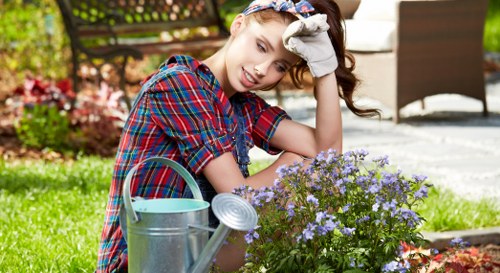Gardening Marylebone: Cultivating Green Spaces in the Heart of London
 Marylebone, nestled in the heart of London, is a vibrant area known for its charming streets, historic architecture, and thriving community. Gardening in Marylebone offers a unique blend of urban living and green spaces, making it a haven for both seasoned gardeners and those new to the art of cultivation. The area's microclimate, diverse plant selections, and community resources create an ideal environment for cultivating beautiful and sustainable gardens.
Marylebone, nestled in the heart of London, is a vibrant area known for its charming streets, historic architecture, and thriving community. Gardening in Marylebone offers a unique blend of urban living and green spaces, making it a haven for both seasoned gardeners and those new to the art of cultivation. The area's microclimate, diverse plant selections, and community resources create an ideal environment for cultivating beautiful and sustainable gardens.
The rich soil and temperate climate of Marylebone provide optimal conditions for a wide variety of plants. From colorful perennials and fragrant herbs to robust vegetables and elegant shrubs, gardeners here have access to an abundance of options to enhance their outdoor spaces. Whether you have a spacious backyard, a cozy balcony, or a community garden plot, Marylebone accommodates all types of gardening endeavors.
One of the key advantages of gardening in Marylebone is the access to local nurseries and garden centers that specialize in plants suited to the area's conditions. These establishments offer expert advice, high-quality seeds, and a diverse selection of flora, ensuring that gardeners can find the perfect plants to thrive in their specific environments.
[IMG_2>Understanding the microclimates within Marylebone is essential for successful gardening. The area's proximity to parks, rivers, and tree-lined streets creates microenvironments that can significantly influence plant growth. For instance, areas shaded by mature trees may require different plant selections compared to sunny, open spaces. By recognizing and adapting to these microclimates, gardeners can optimize the health and productivity of their gardens.
The soil composition in Marylebone varies, ranging from clay to sandy loam, depending on the specific location. Conducting a soil test is a crucial step in preparing your garden, as it helps determine the necessary amendments to improve fertility and drainage. Adding organic matter, such as compost or manure, can enhance soil structure and provide essential nutrients, fostering a thriving garden ecosystem.
Seasonal changes play a significant role in gardening strategies. Marylebone experiences a temperate climate with mild winters and warm summers, allowing for a long growing season. Gardeners can plan their planting schedules to include early spring vegetables, summer blooms, and autumnal harvests. Utilizing seasonal covers and protective structures can also extend the growing period, enabling the cultivation of a diverse array of plants throughout the year.
[IMG_3>Community gardens in Marylebone are vibrant hubs of horticultural activity, bringing together neighbors and fostering a sense of camaraderie through shared gardening experiences. These communal spaces offer opportunities for individuals to cultivate their plots, exchange gardening tips, and participate in collective projects. Community gardens not only enhance the aesthetic appeal of the neighborhood but also contribute to local biodiversity and environmental sustainability.
Engaging in community gardening projects can also provide access to shared resources and tools, reducing the cost and effort associated with individual gardening endeavors. Workshops and events hosted by local garden centers and organizations offer educational opportunities, helping gardeners expand their knowledge and skills in areas such as organic gardening, composting, and pest management.
The presence of urban wildlife, such as bees, butterflies, and birds, in Marylebone's gardens highlights the ecological importance of these green spaces. By incorporating native plants and creating habitats, gardeners can support pollinators and other beneficial species, promoting a balanced and healthy garden ecosystem.
[IMG_4>Choosing the right plants is fundamental to successful gardening in Marylebone. Native and climate-adapted species are often the best choices, as they are more resilient and require less maintenance. Perennials, such as lavender, echinacea, and hostas, provide long-lasting beauty and structure to gardens, while annuals like marigolds and petunias add vibrant seasonal color.
Herb gardens are particularly popular in Marylebone, offering not only ornamental appeal but also practical culinary uses. Herbs such as basil, rosemary, thyme, and mint thrive in the local climate and can be grown in containers or dedicated garden beds. Additionally, cultivating a variety of herbs can attract beneficial insects and deter pests, contributing to a healthier garden environment.
Vegetable gardening is another rewarding aspect of gardening in Marylebone. With a focus on sustainable and organic practices, gardeners can grow their own produce, ensuring fresh and chemical-free vegetables. Popular choices include tomatoes, lettuces, carrots, and peppers, which can be cultivated in raised beds or vertical gardens to maximize space usage.
[IMG_5>Integrating sustainable practices into your gardening routine is both environmentally responsible and beneficial for plant health. Composting kitchen scraps and garden waste not only reduces landfill contributions but also enriches the soil with essential nutrients. Utilizing rain barrels to collect and store rainwater for irrigation helps conserve water and ensures that plants receive consistent hydration, especially during dry spells.
Implementing organic pest control methods, such as introducing beneficial insects or using natural repellents, minimizes the reliance on chemical pesticides. This approach fosters a more balanced ecosystem, protecting both plants and wildlife while maintaining the integrity of the garden.
Marylebone's commitment to green living is evident in the numerous initiatives and resources available to gardeners. Local councils and organizations often provide support through grants, educational programs, and community events, encouraging residents to engage in sustainable gardening practices and contribute to the area's green legacy.
